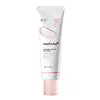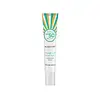What's inside
What's inside
 Key Ingredients
Key Ingredients

 Benefits
Benefits

 Concerns
Concerns

 Ingredients Side-by-side
Ingredients Side-by-side

Water
Skin ConditioningIsononyl Isononanoate
EmollientDipropylene Glycol
HumectantCaprylic/Capric Triglyceride
MaskingTitanium Dioxide
Cosmetic ColorantDibutyl Adipate
EmollientDiisopropyl Sebacate
EmollientEthylhexyl Triazone
UV AbsorberMethyl Trimethicone
Skin ConditioningNiacinamide
SmoothingBis-Ethylhexyloxyphenol Methoxyphenyl Triazine
Skin ConditioningMethylene Bis-Benzotriazolyl Tetramethylbutylphenol
UV FilterSorbitan Isostearate
EmulsifyingBehenyl Alcohol
EmollientDiethylamino Hydroxybenzoyl Hexyl Benzoate
UV FilterPolymethylsilsesquioxane
Potassium Cetyl Phosphate
EmulsifyingC13-15 Alkane
Solvent1,2-Hexanediol
Skin ConditioningCaprylyl Glycol
EmollientGlycerin
HumectantSilica
AbrasiveDecyl Glucoside
CleansingAmmonium Polyacryloyldimethyl Taurate
Emulsion StabilisingPolyacrylate-13
Polyhydroxystearic Acid
EmulsifyingAcrylates/C10-30 Alkyl Acrylate Crosspolymer
Emulsion StabilisingParfum
MaskingSodium Polyacrylate
AbsorbentTromethamine
BufferingAlumina
AbrasiveStearic Acid
CleansingHydrogenated Polyisobutene
EmollientDimethicone/Vinyl Dimethicone Crosspolymer
Skin ConditioningEthylhexylglycerin
Skin ConditioningHydroxypropyl Methylcellulose Stearoxy Ether
Adenosine
Skin ConditioningDisodium EDTA
Polyglyceryl-10 Laurate
Skin ConditioningAluminum Hydroxide
EmollientCyanocobalamin
Skin ConditioningEthylhexyl Palmitate
EmollientTriethoxycaprylylsilane
Xanthan Gum
EmulsifyingT-Butyl Alcohol
PerfumingGlyceryl Acrylate/Acrylic Acid Copolymer
HumectantSodium Hyaluronate
HumectantCollagen Extract
Skin ConditioningHydrolyzed Hyaluronic Acid
HumectantHydrolyzed Sodium Hyaluronate
Skin ConditioningHydroxypropyltrimonium Hyaluronate
Sodium Acetylated Hyaluronate
HumectantSodium Hyaluronate Crosspolymer
HumectantGlutathione
Hyaluronic Acid
HumectantPentylene Glycol
Skin ConditioningPotassium Hyaluronate
Skin ConditioningSodium Dna
Skin ConditioningWater, Isononyl Isononanoate, Dipropylene Glycol, Caprylic/Capric Triglyceride, Titanium Dioxide, Dibutyl Adipate, Diisopropyl Sebacate, Ethylhexyl Triazone, Methyl Trimethicone, Niacinamide, Bis-Ethylhexyloxyphenol Methoxyphenyl Triazine, Methylene Bis-Benzotriazolyl Tetramethylbutylphenol, Sorbitan Isostearate, Behenyl Alcohol, Diethylamino Hydroxybenzoyl Hexyl Benzoate, Polymethylsilsesquioxane, Potassium Cetyl Phosphate, C13-15 Alkane, 1,2-Hexanediol, Caprylyl Glycol, Glycerin, Silica, Decyl Glucoside, Ammonium Polyacryloyldimethyl Taurate, Polyacrylate-13, Polyhydroxystearic Acid, Acrylates/C10-30 Alkyl Acrylate Crosspolymer, Parfum, Sodium Polyacrylate, Tromethamine, Alumina, Stearic Acid, Hydrogenated Polyisobutene, Dimethicone/Vinyl Dimethicone Crosspolymer, Ethylhexylglycerin, Hydroxypropyl Methylcellulose Stearoxy Ether, Adenosine, Disodium EDTA, Polyglyceryl-10 Laurate, Aluminum Hydroxide, Cyanocobalamin, Ethylhexyl Palmitate, Triethoxycaprylylsilane, Xanthan Gum, T-Butyl Alcohol, Glyceryl Acrylate/Acrylic Acid Copolymer, Sodium Hyaluronate, Collagen Extract, Hydrolyzed Hyaluronic Acid, Hydrolyzed Sodium Hyaluronate, Hydroxypropyltrimonium Hyaluronate, Sodium Acetylated Hyaluronate, Sodium Hyaluronate Crosspolymer, Glutathione, Hyaluronic Acid, Pentylene Glycol, Potassium Hyaluronate, Sodium Dna
Water
Skin ConditioningTitanium Dioxide
Cosmetic ColorantZinc Oxide
Cosmetic ColorantGlyceryl Stearate
EmollientGlycerin
HumectantSqualane
EmollientSilica
AbrasivePropanediol
SolventEctoin
Skin ConditioningPhytol
EmollientIsomalt
HumectantSodium Hyaluronate
HumectantAcrylates Crosspolymer
AbsorbentAllantoin
Skin ConditioningPhenoxyethanol
PreservativeAcetyl Hexapeptide-8
HumectantChlorphenesin
AntimicrobialCeramide NP
Skin ConditioningDisodium EDTA
Xanthan Gum
Emulsifying
 Reviews
Reviews

Ingredients Explained
These ingredients are found in both products.
Ingredients higher up in an ingredient list are typically present in a larger amount.
Disodium EDTA plays a role in making products more stable by aiding other preservatives.
It is a chelating agent, meaning it neutralizes metal ions that may be found in a product.
Disodium EDTA is a salt of edetic acid and is found to be safe in cosmetic ingredients.
Learn more about Disodium EDTAGlycerin is already naturally found in your skin. It helps moisturize and protect your skin.
A study from 2016 found glycerin to be more effective as a humectant than AHAs and hyaluronic acid.
As a humectant, it helps the skin stay hydrated by pulling moisture to your skin. The low molecular weight of glycerin allows it to pull moisture into the deeper layers of your skin.
Hydrated skin improves your skin barrier; Your skin barrier helps protect against irritants and bacteria.
Glycerin has also been found to have antimicrobial and antiviral properties. Due to these properties, glycerin is often used in wound and burn treatments.
In cosmetics, glycerin is usually derived from plants such as soybean or palm. However, it can also be sourced from animals, such as tallow or animal fat.
This ingredient is organic, colorless, odorless, and non-toxic.
Glycerin is the name for this ingredient in American English. British English uses Glycerol/Glycerine.
Learn more about GlycerinSilica, also known as silicon dioxide, is a naturally occurring mineral. It is used as a fine, spherical, and porous powder in cosmetics.
Though it has exfoliant properties, the function of silica varies depending on the product.
The unique structure of silica enhances the spreadability and adds smoothness, making it a great texture enhancer.
It is also used as an active carrier, emulsifier, and mattifier due to its ability to absorb excess oil.
In some products, tiny microneedles called spicules are made from silica or hydrolyzed sponge. When you rub them in, they lightly polish away dead skin layers and enhance the penetration of active ingredients.
Learn more about SilicaSodium Hyaluronate is hyaluronic acid's salt form. It is commonly derived from the sodium salt of hyaluronic acid.
Like hyaluronic acid, it is great at holding water and acts as a humectant. This makes it a great skin hydrating ingredient.
Sodium Hyaluronate is naturally occurring in our bodies and is mostly found in eye fluid and joints.
These are some other common types of Hyaluronic Acid:
Learn more about Sodium HyaluronateTitanium dioxide is a mineral UV filter widely used in sunscreens and cosmetics.
It is one of only two UV filters officially classified as “mineral” by regulatory agencies, the other being zinc oxide.
Titanium dioxide provides broad-spectrum protection mostly in the UVB and UVAII range, with some protection in the UVAI range.
While its UVA protection isn’t as strong as zinc oxide’s, the difference is minor.
A common myth is that mineral UV filters reflect UV light. However, modern research shows titanium dioxide absorbs UV radiation like chemical filters (~95% absorption & 5% reflection).
Thanks to its non-irritating nature, titanium dioxide is suitable for sensitive, acne-prone, or redness-prone skin. It is unlikely to cause "eye sting" like other sunscreen ingredients.
A major drawback of this ingredient is its white cast and thick texture. This is why mineral sunscreens often leave a white cast and are less cosmetically elegant than chemical/hybrid sunscreens.
To improve white cast and spreadability, micronized or nano-sized titanium dioxide is often used.
There are ongoing concerns surrounding nano-titanium oxide's impact on marine ecosystems.
There is no conclusive evidence that any form of titanium oxide (or any other sunscreen ingredients) will cause harm to marine ecosystems or coral reefs. The science is still developing but many consumers are keeping a close eye on this issue.
Please note, many destinations have reef-safety sunscreen rules. For instance, the U.S. Virgin Islands advises all visitors to use non-nano mineral sunscreens.
Nano mineral sunscreens once raised safety concerns about absorption into skin.
Extensive research has shown that they do not penetrate healthy or damaged skin; they remain safely on the surface and the top layer of dead skin (stratum corneum).
You'll likely find titanium dioxide bundled with alumina, silica, or dimethicone. These ingredients help make titanium dioxide highly photostable; this prevents it from interacting with other formula components under UV light.
Learn more about Titanium DioxideWater. It's the most common cosmetic ingredient of all. You'll usually see it at the top of ingredient lists, meaning that it makes up the largest part of the product.
So why is it so popular? Water most often acts as a solvent - this means that it helps dissolve other ingredients into the formulation.
You'll also recognize water as that liquid we all need to stay alive. If you see this, drink a glass of water. Stay hydrated!
Learn more about WaterXanthan gum is used as a stabilizer and thickener within cosmetic products. It helps give products a sticky, thick feeling - preventing them from being too runny.
On the technical side of things, xanthan gum is a polysaccharide - a combination consisting of multiple sugar molecules bonded together.
Xanthan gum is a pretty common and great ingredient. It is a natural, non-toxic, non-irritating ingredient that is also commonly used in food products.
Learn more about Xanthan Gum